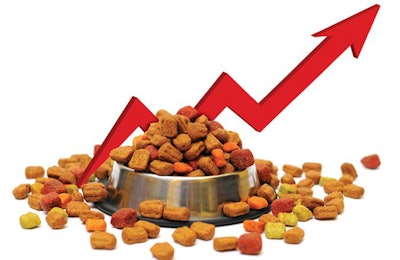
When it comes to ongoing pet food inflation, there’s good news and bad news. The good: In the U.S., pet food producer prices have declined year over year (YOY), with an increase of 10.5% in February 2023 over February 2022. That was down from January 2023’s 12.5% YOY increase.
The bad new is that pet food retail prices remain stubbornly high, not only in the U.S. but also in many other markets. The U.S. February 2023 YOY figure was 15.2%, following 15.1% in January and 15.2% in December 2022. I guess the silver lining is that the pet food inflation number has stabilized in the U.S., yet it’s still a pain point for many pet owners and retailers.
(This data comes from the U.S. Bureau of Labor Statistics, which was then helpfully compiled and analyzed by John Gibbons of PetBusinessProfessor.com.)
Pet food inflation pain in other markets, too
Though the overall consumer price index (CPI) in the U.S. was down YOY in February, at 6%, “food at home” (essentially groceries) registered at a still uncomfortable 10.8%. That’s not as bad as pet food, though, which started outpacing human food inflation in September 2022 and has stayed elevated.
Unfortunately, the U.S. is not alone in terms of human food and pet food inflation; both remain distressingly high in multiple markets. For example, in Canada, overall inflation was at 5.2% YOY in February, while inflation for food (groceries) was nearly double at 10.6%, and pet food and supplies (grouped in one category) was even higher, 12.8%.
In Europe, the picture looks even bleaker: In the U.K., overall inflation stood at 9.2% YOY, with food inflation a whopping 18.2%; surprisingly, pet care inflation was lower at 12.6%. (The U.K. includes pet food in a general pet care category.) While overall inflation in the European Union was slightly less than the U.K., 8.5% YOY, food was a similarly painful 17.7% and, pet care (also including pet food) was 18%, even outpacing pet food inflation in the U.S.
In more developing markets, like Mexico and Brazil, pet food/pet care inflation data is not readily available, but as in other markets, food inflation is worse than overall inflation. Mexico’s overall inflation stood at 7.6% YOY in February, with food at 12.29%; in Brazil, the figures were 5.6% and 9.84%, respectively.
Outlook: Ongoing high inflation for the foreseeable future?
We can hope that a more tolerable pet producer price index, at least in the U.S., means pet food retail prices will continue to stabilize and, ideally, even decline—but as pet food inflation seems to track human food inflation, we may need to brace for ongoing discomfort for the foreseeable future. In Europe, its proximity to the Russian invasion of Ukraine and all its effects throughout the supply chain and economy likely mean little to no relief is in sight just yet.


















